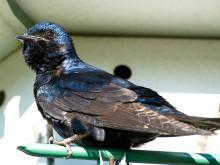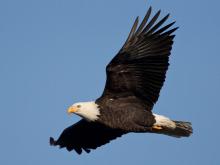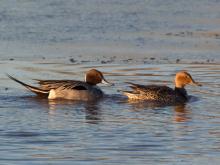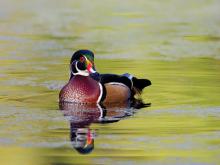Birds
Media

Species Types
Scientific Name
Petrechelidon pyrrhonota
Description
Cliff swallows fly in swarms around their clusters of juglike mud nests attached to overpasses, bridges, and other structures. Note the whitish forehead, buffy rump patch, and chestnut throat.
Media

Species Types
Scientific Name
Quiscalus mexicanus
Description
The great-tailed grackle occurs mostly in western parts of Missouri, which is on the northeastern edge of its range. This blackbird’s long, V-shaped tail is distinctive, as is its song of whistles, clacks, chucks, and clicks.
Media

Species Types
Scientific Name
Progne subis
Description
Generations of Americans have greeted the annual return of purple martins, with their cheerful calls, graceful flight, and faithful reappearance each year. But martin populations have been declining. Find out what you can do to help these agile fliers.
Media

Species Types
Scientific Name
Haliaeetus leucocephalus
Description
Our national symbol, the mature bald eagle is unmistakable with its dark brown body, yellow bill, and white head and tail. It soars with wings held flat and can have a 7-foot wingspan.
Media

Species Types
Scientific Name
Gallinago delicata
Description
Wilson’s snipe, formerly called the common snipe, is a migratory game bird in Missouri. Like its relative the woodcock, this member of the sandpiper family is not usually seen on mudflats. It prefers swamps and wet, grassy areas.
Media

Species Types
Scientific Name
Spatula clypeata (formerly Anas clypeata)
Description
Northern shovelers are dabbling ducks with remarkably long, heavy-looking bills. The male’s green head may remind you of a mallard’s, but the bill is far heavier.
Media

Species Types
Scientific Name
Anas strepera
Description
The male gadwall is a rather drab-looking duck with a black rear end and a white speculum (wing patch). This dabbling duck is a common migrant in Missouri.
Media

Species Types
Scientific Name
Anas acuta
Description
A dabbling duck named for its long, tapered tail, the northern pintail is a common migrant in Missouri. Like other dabblers, it can leap into flight right from the surface of the water.
Media

Species Types
Scientific Name
Anas crecca
Description
The green-winged teal is a fast, graceful flyer with an iridescent green wing patch. Teals are relatively small dabbling ducks and have been called the “bantams of the duck tribe.”
Media

Species Types
Scientific Name
Aix sponsa
Description
The wood duck is one of the world's most beautiful waterfowl. It is equally famous for being a cavity nester in hollow trees, sometimes 60 feet above the ground and a mile away from water.
See Also







Media

Species Types
Scientific Name
Hemaris diffinis
Description
The snowberry clearwing is a moth that confuses people because it looks like a bumblebee and flies like a hummingbird!
Media

Species Types
Scientific Name
Hyles lineata
Description
The white-lined sphinx moth sometimes confuses people because it flies, hovers, and eats from flowers like a hummingbird. The adults often fly during daylight hours as well as in the night and are often found at lights.
Media

Species Types
Scientific Name
Darapsa myron
Description
The Virginia creeper sphinx moth is common in woods and brushy areas and comes to lights at night. The larvae eat Virginia creeper and grape leaves.
Media

Species Types
Scientific Name
Perimyotis subflavus (formerly Pipistrellus subflavus)
Description
Tri-colored bats, formerly called eastern pipistrelles, are relatively small and look pale yellowish or pale reddish brown. The main hairs are dark gray at the base, broadly banded with yellowish brown, and tipped with dark brown.
Media

Species Types
Scientific Name
Myotis grisescens
Description
Gray myotises are difficult to distinguish from other mouse-eared bats. A key identifying feature of the gray myotis is that its wing is attached to the ankle and not at the base of the toes. It’s an endangered species.
Media

Species Types
Scientific Name
Myotis lucifugus
Description
The little brown myotis (little brown bat) is one of our most common bats, but populations are declining. White-nose syndrome has taken a heavy toll in northeastern states. This species is now listed as vulnerable across its range.
Media

Species Types
Scientific Name
Myotis sodalis
Description
The Indiana myotis, or Indiana bat, summers along streams and rivers in north Missouri, raising its young under the bark of certain trees. It is an endangered species.
About Birds in Missouri
About 350 species of birds are likely to be seen in Missouri, though nearly 400 have been recorded within our borders. Most people know a bird when they see one — it has feathers, wings, and a bill. Birds are warm-blooded, and most species can fly. Many migrate hundreds or thousands of miles. Birds lay hard-shelled eggs (often in a nest), and the parents care for the young. Many communicate with songs and calls.





















